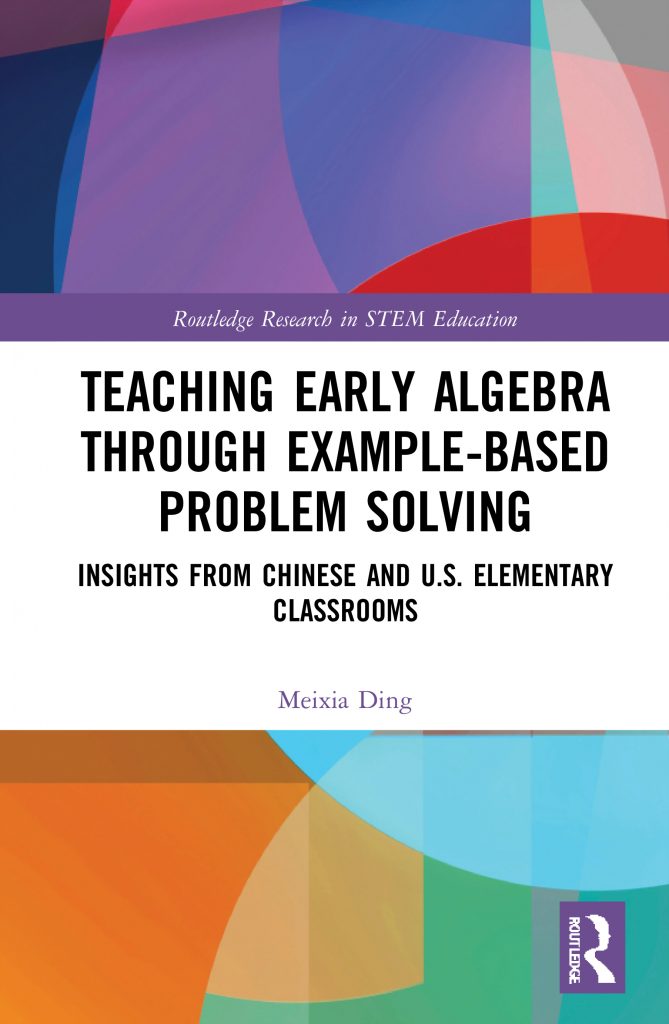G indicates graduate student author; U indicates undergraduate student author
Book
Ding, M. (Upcoming, 2026). Teaching through example-based problem solving (TEPS) in early algebra: Contrasting cases in elementary math. Routledge. (ISBN: HB – 9781032957470; EB – 9781003586333; PB – 9781032957463)
- This book is reviewed by: Jiang, C., & Cai, J. (2022). Book Review: Seeing algebra in arithmetic in cross-cultural contexts. Education Studies in Mathematics. https://doi.org/10.1007/s10649-021-10132-2 Jiang & Cai (2022)_BookReview_ESM
Journal Articles in English
Ding, M., G Mochaourab, R, & G Spiro, B. (2024). Promoting changes in elementary mathematics teaching: A case with inverse relations. Asian Journal for Mathematics Education. https://doi.org/10.1177/27527263241256678
G Meng, R., Yeo, A., Ding, M. & Alibali, M.W (2023). Linking representations of mathematical equivalence in first-grade lessons in China. Educational Research for Policy and Practice. doi: 10.1007/s10671-023-09334-7
Ding, M., Byrnes, J., & G Ke, X. (2023). Rethinking the role of “quality instruction” in predicting algebraic learning within an opportunity-propensity framework: An exploratory cross-cultural study. Journal of Educational Psychology, 115(2), 241–266. https://doi.org/10.1037/edu0000767
Ding, M., Li, X., U Manfredonia, , & U Luo, W. (2023). US and Chinese elementary teachers’ noticing of cross-cultural mathematics videos. Journal of Mathematics Teacher Education, 26, 211–239. doi: 10.1007/s10857-021-09526-z PDF
Ding, M., G Hassler, R. & Li., X., (2021). Cognitive instructional principles in elementary mathematics classrooms: A case of teaching inverse relations. International Journal of Mathematical Education in Science and Technology, 52(8), 1195-1224. doi: 10.1080/0020739X.2020.1749319. PDF
Ding, M., Li, X., G Hassler, R., & G Barnett, E. (2021). Understanding of the properties of operations: A cross-cultural analysis. International Journal of Mathematical Education in Science and Technology, 52(1), 39-64. doi: 10.1080/0020739X.2019.1657595. PDF
Ding, M., G Chen, W., & G Hassler, R. (2019). Linear quantity models in the US and Chinese elementary mathematics classrooms. Mathematical Thinking and Learning, 21, 105-130. doi: 10.1080/10986065.2019.1570834 . PDF
G Barnett, E., & Ding, M. (2019). Teaching of the associative property: A natural classroom investigation. Investigations of Mathematics Learning, 11, 148-166. doi: 10.1080/19477503.2018.1425592 PDF
Ding, M., & G Heffernan, K. (2018). Transferring specialized content knowledge to elementary classrooms: Preservice teachers’ learning to teach the associative property. International Journal of Mathematics Educational in Science and Technology, 49, 899-921.doi: 10.1080/0020739X.2018.1426793 PDF
Ding, M. (2018). Modeling with tape diagrams. Teaching Children Mathematics, 25, 158-165. doi: 10.5951/teacchilmath.25.3.0158 PDF
G Chen, W., & Ding, M.* (2018). Transitioning from mathematics textbook to classroom instruction: The case of a Chinese expert teacher. Frontiers of Education in China, 13, 601-632. doi: 10.1007/s11516-018-0031-z (*Both authors contributed equally). PDF
Ding, M., & G Auxter, A. (2017). Children’s strategies to solving additive inverse problems: A preliminary analysis. Mathematics Education Research Journal, 29, 73-92. doi:10.1007/s13394-017-0188-4 PDF
Ding, M. (2016). Developing preservice elementary teachers’ specialized content knowledge for teaching fundamental mathematical ideas: The case of associative property. International Journal of STEM Education, 3(9), 1-19. doi: 10.1186/s40594-016-0041-4 PDF
Ding, M. (2016). Opportunities to learn: Inverse operations in U.S. and Chinese elementary mathematics textbooks. Mathematical Thinking and Learning, 18, 45-68. doi: 10.1080/10986065.2016.1107819 PDF
Journal Articles in Chinese
(Note: Educational Research and Evaluation (Elementary Education and Instruction) 教育研究与评论 (小学教育教学) and Curriculum and Instructional Methods (课程教材教法) are both official, core journals in mathematics education field in China.
- G Chen, W. (2018). Representation uses in mathematics teaching – an analysis of expert’s classroom instruction. Curriculum and Instructional Methods, 6, 65-70. 数学教学的表征处理策略——基于专家教师的课堂教学分析. 课程教材教法, 6, 65-70. PDF
- Ma, F. ( 2018) – Necessary algebraic knowledge for elementary teachers- an ongoing cross-cultural study. Educational Research and Evaluation (Elementary Education and Instruction), 2, 5-7. 小学教师必备的代数学科知识-跨文化研究进行时。教育研究与评论 (小学教育教学),2, 5-7. PDF
- Chen, J. (2018) Infusion and development of children’s early algebraic thinking – a comparative study of the US and Chinese elementary mathematics teaching. Educational Research and Evaluation (Elementary Education and Instruction), 2,8-13. 儿童早期代数思维的渗透与培养-中美小学数学教学比较研究。教育研究与评论(小学教育教学),2, 8-13. PDF
- Zong, L. (2018). A comparative study on the infusion of inverse relations in the US and Chinese classroom teaching. Educational Research and Evaluation (Elementary Education and Instruction), 2, 14-19. 中美逆运算渗透教学对比研究。教育研究与评论(小学教育教学),2, 14-19. PDF
- Wu, X. (2018). Mathematical representations and development of children’s mathematical thinking: A perspective of US-Chinese comparison. Educational Research and Evaluation (Elementary Education and Instruction), 2, 20-24. 数学表征与儿童数学思维发展-基于中美比较视角。教育研究与评论(小学教育教学),2, 20-24. PDF
Dissertations:
Hassler, R. (2016). Mathematical comprehension facilitated by situation models: Learning opportunities for inverse relations in elementary school. Published dissertation, Temple University, Philadelphia, PA. (Chair: Dr. Meixia Ding) PDF
Chen, W. (2018). Elementary mathematics teachers’ professional growth: A perspectives of TPACK (TPACK 视角下小学数学教师专业发展的研究). Dissertation, Nanjing Normal University. Nanjing, China. PDF
Relevant Prior Research:
Ding, M. (2015). Early algebra in Chinese elementary mathematics textbooks: The case of inverse relations. In B. Sriraman, J. Cai, K. Lee, L. Fan, Y. Shimuzu, L. C. Sam, & K. Subramanium (Eds.), The first sourcebook on Asian research in mathematics education: China, Korea, Singapore, Japan, Malaysia, & India (pp.337-363). Charlotte, NC: Information Age Publishing.
Ding, M., & Li, X. (2014). Transition from concrete to abstract representations: The distributive property in a Chinese textbook series. Educational Studies in Mathematics, 87, 103–121. doi: 10.1007/s10649-014-9558-y PDF
Ding, M., & G Carlson, M. A. (2013). Elementary teachers’ learning to construct high quality mathematics lesson plans: A use of IES recommendations. The Elementary School Journal, 113, 359–385. doi:10.1086/668505 PDF
Ding, M., Li, X., & Capraro, M. (2013). Preservice elementary teachers’ knowledge for teaching the associative property: A preliminary analysis. Journal of Mathematical Behavior, 32, 36–52. http://dx.doi.org/10.1016/j.jmathb.2012.09.002 PDF
Ding, M., Li, X., Capraro, M. M., & Capraro, R. M. (2012). Supporting meaningful initial learning of the associative property: Cross-cultural differences in textbook presentations. International Journal for Studies in Mathematics Education, 5(1), 114–130. PDF
Ding, M., & Li, X. (2010). A comparative analysis of the distributive property in the U.S. and Chinese elementary mathematics textbooks. Cognition and Instruction, 28, 146–180. doi: 10.1080/07370001003638553 PDF
Li, X., Ding, M., Capraro, M. M., & Capraro, R. M. (2008). Sources of differences in children’s understandings of mathematical equality: Comparative analysis of teacher guides and student texts in China and in the United States. Cognition and Instruction, 26, 195–217. doi:10.1080/07370000801980845 PDF
Capraro, M. M., Ding, M., Matteson, S., Li, X., & Capraro, R. M. (2007). Representational implications for understanding equivalence. School Science and Mathematics, 107, 86–88. doi: 10.1111/j.1949-8594.2007.tb17773.x PDF
Capraro, R. M., Capraro, M. M., Ding, M., & Li, X. (2007). Thirty years of research: Interpretations of the equal sign in China and the USA. Psychological Reports, 101, 784–786. doi: 10.2466/pr0.101.3.784-786 PDF

